Every new year in Japan, retailers put together bags, call them Lucky Bags, Happy Bags, Grab Bags, what-have-you, but essentially they are a collection of goodies for a good price. I bought the 2008 Muji Happy Bag, and here are pictures of what was inside.
This idea of “Lucky Bags” (essentially grab bags) is new to me. I heard about it just the other day, and it was explained to me like this:
Do you know fukubukuro? (福袋 – literally good fortune bag) It is a bag at a store. It costs maybe 1000 yen, but has 3000 yen of stuff inside!
Now, I’m no business major or economist, but that sounds like a bad deal for the retailer. Thinking about it though, it is a really interesting idea. I’m sure that the retailers don’t take a loss on these things – the margins are probably very low on them – but the idea is somewhat similar to the Black Friday sales you see the day after Thanksgiving in America. So the day after Thanksgiving, stores sell stuff at ridiculously outrageous prices, certainly taking a hit on some of the deals as “loss leaders” just trying to get people into the store. These are probably operating on the same, or at least similar, model. Get people into the store, and they will pick up some other stuff along with your Happy Bag (I kind of like that as the translation instead of Lucky Bag.)
The way these bags work is that you generally have a bag for some set price, say 3000 yen, and unknown contents inside. Generally you can’t see into the bag so you don’t know what is in there. It’s a gamble. (Given the Japanese peoples incomprehensible love of Pachinko it comes to no surprise to me that they like the idea of a random gamble on a bag of unknown stuff.) This strikes me as an interesting propsition on two grounds: it is good for the merchant because you can use the happy bag as not just a loss leader, a way to draw people into the store, but also as a way to manage inventory: you need to get rid of the 2007 models and make room for the new, trendy 2008 models. I don’t follow Japanese fashion magazines, but this place is dominated by magazines that set trends (see Neojapanisme, clast, or jeansnow.net for more about that) and last year’s stuff just won’t do. Since you are selling this bag of stuff, you can throw in things that didn’t sell well or that you are overstocked on, drop the price a bit, and people are happy because they are getting a good deal. That’s a win-win situation. It also has the advantages of a video game system bundling deal: you can put in a few stinkers with the winners and hopefully people will overlook that fact.
Having the Happy Bags be opaque is very interesting because now the merchant is faced with a problem: dump a lot of crap that isn’t worth much into the bag and make some money, or put really good stuff in there, possible take a loss, but possible gain customer loyalty in the process? It is a tough call. Personally, I wouldn’t want to a get, for example, a Don Quixote happy bag, but I’m pretty sure I would be interested in a Muji or Uniqulo happy bag. Anyway, I have more confidence that Japanese companies would take the long-term view and generally try to put good stuff in their bags. I’m not sure that I would trust American companies to do that same thing. I think the closest thing, the Black Friday sales in America, are similar but have some bad sides to them as well: for example, generally the best deals are limited to a certain number per store, and now have resulted in not-infrequent tramplings and mad rushes at the stores. I don’t think that happens as much in Japan, but then again I didn’t line up for any 初売り (first shopping!) trips either.
Anyway, the short of it is that I went and bought the Muji Happy Bag this year. It is the first year I had ever heard about them, and I was thinking of stopping by Muji and picking up some socks and a hat. Thinking about the bag, maybe there would be socks and a hat in there. Muji seems unusual in that their Happy Bag is see-through. I like Muji a lot. I haven’t written about it, but I think that the idea of a brand that is personified by the lack of branding, is really interesting. Japan is more or less brand obsessed, and a brand that is unbranded is still somehow a brand (you can tell by color schemes, design scheme, style, function, and so on.) Anyway, they expect that they can sell more bags when people know their contents as opposed to not. I think that is because Muji is an honest and reliable store. And I like their socks.
So here is a breakdown of what was in their bag:
- A large wool Jacket
- Two pair of boxer shorts
- One India Linen bag (?)
- Three pair of short socks
- One pair of long socks
- One short scarf
I have to say that the bag was worth it if for the Jacket alone. It is a really nice large wool Jacket. Of course, I got the large bag – the bag also comes in small I suppose – so the jacket actually fits pretty well. I’m really pleased with just the jacket, but wait, there’s more! You also get two pair of boxer shorts (can’t go wrong with those), three pairs of short socks (I was hoping for some socks!), one pair of long socks (they look warm), one short scarf, and one Indian Linen bag. Now, I’m a little confused about the linen bag, since I’m not really sure what it is supposed to be for. A dirty laundry bag? Something that stands up is more useful for that task. A shopping bag? There are no convenient handles. Really, I’m kind of at a loss here. It is totally in line with Muji’s style, but just not something that I have a use for. I am currently using it as a tablecloth on a small table. It is doing a good job, but I feel like I should put something inside it. (But what?)
Anyway, I like this idea of Happy Bags. I have a lot of blogs written by foreigners in Japan, and over on Tokyo Manga Lisa writes about the women’s Muji vs. Uniqlo Happy Bags.

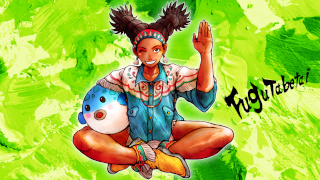
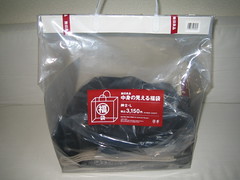
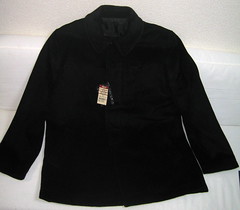
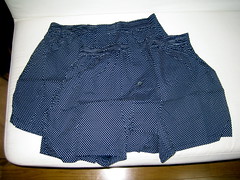

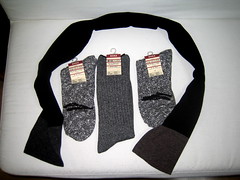
Leave a Reply